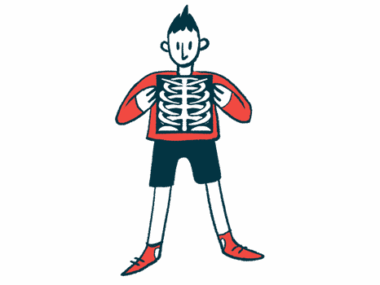Motor gains seen in children using body weight support harness
At-home PUMA system designed for children weighing up to 60 pounds
Written by |

A harness system designed for children with movement difficulties, the Portable Mobility Aid for Children (PUMA) improved or stabilized motor function among young patients treated for spinal muscular atrophy (SMA) in a small study.
More frequent at-home use of the system, whose harness supports a child’s weight, was associated with greater motor improvements across several standard assessment tools, data showed.
Feedback from families regarding the perceived impact of PUMA on motor and nonmotor skills, the child’s enjoyment, and ease of use was overwhelmingly positive.
Testing details were in the study “Feasibility and utility of in-home body weight support harness system use in young children treated for spinal muscular atrophy: A single-arm prospective cohort study,” published in the journal PLOS One.
Body weight support harness aims to facilitate child’s movement
SMA is due to the loss of motor neurons, the nerve cells that control voluntary muscle movement, leading to progressive muscle weakness and disease symptoms that limit such essential skills as walking and sitting up.
Advances in disease-modifying therapies (DMTs) have changed the natural course of SMA, stabilizing or improving motor abilities. Still, their benefits can depend on the age when DMT treatment begins and the extent of pretreatment symptoms.
Body weight support systems (BWSS) have the potential to enhance long-term motor skill gains by helping a child to practice moving in a partial weight-bearing environment.
However, traditional body weight support systems are large, heavy devices commonly positioned over a treadmill, and most are available in medical facilities, which limits the time children can spend practicing movement-related activities.
The PUMA system, by Enliten, is a commercially available, portable and adjustable BWSS unit for use in the home. Resembling a camping tent frame, PUMA occupies a 9-by-9-foot area (80 square feet or about 7.5 square meters) and can fit around household furniture. Its interconnecting crossbars allow 360-degree mobility within frame boundaries, helping children with little muscle strength to move independently, secured in a fabric harness attached to hanging cords.
Scientists at Nationwide Children’s Hospital, in Ohio, designed a pilot study (NCT05715749) to test the feasibility and utility of PUMA in children with SMA. The study partly was funded by Novartis, which markets the gene therapy Zolgensma.
It enrolled 33 children with SMA type 1 or type 2 (15 girls, 18 boys) who weighed at most 50 pounds (about 23 kg), had upright head control, and confirmed motor delay. PUMA is designed for children up to 60 lbs.
All had past treatment with a DMT or were currently under treatment, with DMT use starting when the children were about 1 year old (average age, 0.94 years). The group’s mean age at enrollment was 2.9 years (range, 0.8 to 9.4 years).
PUMA system used for weekly average of 4.1 hours over six months
Investigators visited family homes to set up the BWSS, and they provided instructions on its proper and safe use. Families started with the bungee cord system that allows variable body weight support, with the option to switch to a counterweight system that provides a set amount of support. Families continued with any current habilitative treatment, such as physical therapy.
Families used the BWSS daily for six months, with patients’ motor performance assessed before BWSS and again after three and six months of PUMA’s use. Before BWSS, all children were able to sit independently, and six were able to crawl, four stood with assistance, one could stand alone, and two walked with assistance. None could walk without assistance.
Motor function assessment included the Neuromuscular Gross Motor Outcome (GRO), the Hammersmith Functional Motor Scale Expanded (HFMSE), the Revised Hammersmith Scale (RHS), and the Gross Motor Subtest of the Bayley Scales of Infant and Toddler Development version 3.0 (Bayley GM).
On average, BWSS was used for 4.1 hours each week. Most families continued with the bungee system, as the counterweight system “can be more difficult to operate independently … and less fun,” the scientists noted.
Of the 32 children whose data were evaluated in the study, 10 (31%) gained 19 new milestones, including crawling, standing with assistance, and walking with assistance. Two children (6%) showed improved Bayley GM scores.
Based on average hours per week, more frequent use of BWSS significantly correlated with better performance on motor outcomes across all assessments. In contrast, no relationship was evident between changes in motor function and additional exercises or therapies.
Statistical modeling suggested that for each additional hour of BWSS per week, there was an expected mean improvement of 0.81 GRO points, 0.85 HFMSE points, 1.02 on the RHS, and 1.07 with Bayley GM after adjusting for pretreatment scores. Considering a child’s age, additional therapy time, and time since treatment did not change the model.
“As our cohort is not limited to children who recently initiated DMTs … or initiated DMTs within the first weeks of life … our findings suggest that regular BWSS use may help optimize treatment gains in children even 2+ years post-treatment,” the scientists wrote.
88% of families providing feedback found experience favorable
Of the 26 families who completed a feedback survey, 88% of responses supported favorable experiences, with scores of four or five. These scores reflected the perceived impact of BWSS on motor and nonmotor skills, the child’s perceived enjoyment, the ease of equipment use, and whether PUMA’s use was beneficial.
Fourteen responses (10%) were neutral and two (2%) were unfavorable. The two unfavorable and one of the neutral responses came from three families with boys, reporting discomfort in the child’s groin that ended once the harness was removed.
“[My son] was not able to use the harness much, his body was just too awkward so he could not tolerate the discomfort caused by the harness,” a parent wrote.
No other adverse events were reported. The three boys with groin discomfort were the study’s oldest (two age 6 and one age 9) and largest children, the scientists noted.
“My daughter loves the harness! It allowed her to be a ballerina with her siblings,” one parent wrote. “It also strengthened her legs tremendously. We especially appreciated the harness in the colder months when we aren’t outside. I would highly recommend the harness to anyone in need.”
Another noted that “it took a week or so before [my son] started enjoying time in the harness … but after that period he enjoyed the freedom and independence it gave him to play and to move around with his sister. We truly believe it played an important roll in the improvement of his motor skills” — and combined with medicine and other therapies “in just 6 months he gained the ability to kneel, push up to sitting, crawl, pull up to standing, stand almost on his own, great with braces and even take a few steps with braces!”
Study limitations included its small size and limited duration.
“A BWSS system should be considered as a therapeutic modality for young children treated for SMA,” the researchers concluded. The system was “safe, feasible, well-tolerate by families, and may be useful for optimizing gross motor abilities.”







